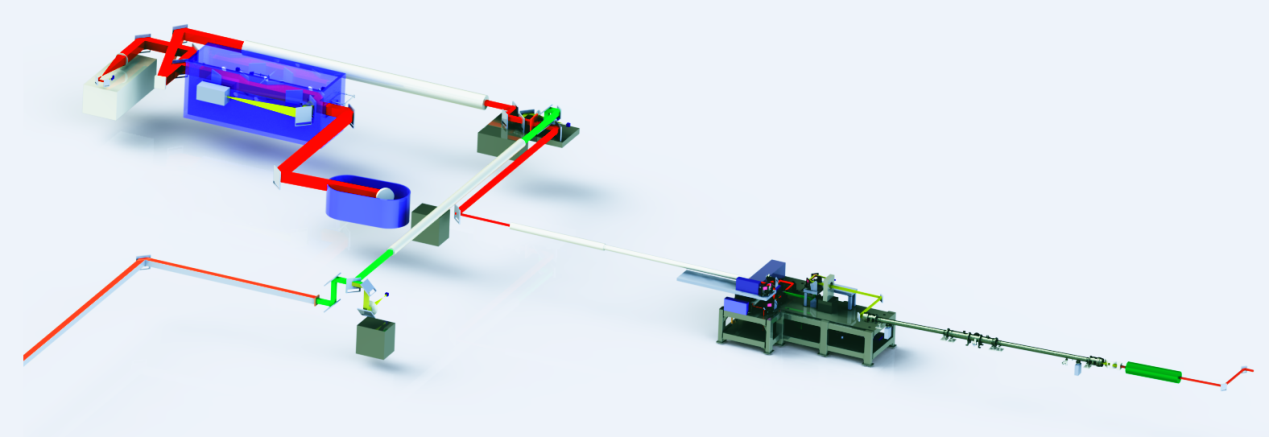Femtosecond Peta-Watt (PW) laser facilities are important platforms for strong field physics research. Many countries and laboratories have carried out studies and developments of such large laser facilities. However, output characteristics of the PW lasers are different from other types of laser devices. Laser pulse with hundreds of nanometers in spectral bandwidth and high contrast on petawatt power scale must be focused up to the diffraction limit. To a large extent, it demands the spatiotemporal characteristics and beam directivity. Without other characteristics, a very high parameter such as power or energy can not guaranttee the laser’s availability for physical experiment. Until now, there are very few fs-PW laser facilities that can operate stably and serve physical experiments.
The National Laboratory on High Power Laser and Physics, Shanghai Institute of Optics and fine Mechanics, Chinese Academy of Sciences, (NLHPLP, SIOM, CAS), have independently designed and constructed the SG-II 5PW laser facility, taking advantage of SG-II laser facility as high-quality pump source.
In the laboratory, optical parametric chirp pulse amplification (OPCPA) is adopted as the general technical route. With three OPCPA amplification stages, SG-II 5PW laser will be capable of delivering 150J/ 30 fs to the target. Figure 1 shows the layout of SG-II 5PW laser. The device was designed in pursuit of high-quality output laser performance, independent operation and combined operation with other laser beams of SG-II laser facility. After the completement of SG-II 5PW laser facility, it will become an organic component of the integrated SG-Ⅱ laser-physics platform, which is multi-functional and can realize target shooting with pulses of various duration, energy, wavefront and light frequency.

Figure 1. The layout of SG-Ⅱ 5PW laser facility.
The construction status of SG-II 5PW facility is divided into two phases: Phase-I is the validation of petawatt laser output, and Phase-II is to promote output stability and controllability in order to meet the demands of experiment. At present, the output has reached 1.76 PW with the prior two OPCPA stages. The output of 5PW can be expected after the installation of large aperture LBO crystal (high deuterated DKDP crystal optional) for the third stage of OPCPA. For Phase-II, two rounds of online experiments, carried out since 2018, have greatly improved the comprehensive performance of the laser facility: 1) the conversion efficiency of the high energy optical parametric amplifier is 41.9%, which is the highest result reported internationally; 2) with the installation of the aberration pre-compensation unit for the whole system, the full-spectrum static optical focal spot diameter after the adaptive optical (AO) correction is measured less than 4.4 μm by CCD in the target chamber (Fig. 2 (a) (b)), and the focal-spot size is approaching the ideal diffraction limitation, which is parallel with the similar devices; 3) the full-aperture Signal to Noise Ratio (SNR) measured near the focal spot is better than 108:1 (Fig. 2 (c)).

Figure 2. (a) the static optical focal spot measured by CCD with full spectrum, (b) the static distribution of focal spot along longitudinal and transverse axis, (c) SNR measured near the focal spot.
In March 2019, based on the accomplishment of SG-Ⅱ 5PW performance optimization, the group of Prof. ZHU Jianqiang and Prof. XIE Xinglong from SIOM together with the team from Shanghai Institute of Laser Plasma, China Academy of Engineering Physics, have jointly completed a latest round of proton acceleration experiment.
In the experiment, the flat copper targets of various thickness were adopted to interact with the laser pulses. The X-ray focal spot size (FWHM) measured by pinhole camera was 21μm*21μm (Fig. 3 (a)) and the proton acceleration kinetic energy of more than 16MeV was obtained for 5μm-thick copper target. Fig. 3 (b) is the patterns recorded by RCF, the spatial distribution of which is uniform as shown in Fig. 3 (c). Both strength and mass of the proton beams can meet the needs of proton imaging experiment. A focused density exceeding 1020W/cm2 can be deduced reversely by the proton acceleration kinetic energy.
In this physical study, 10 shots of high-energy laser have been completed, and 9 of them were successful. Using the copper targets with thickness ranging from 0.8 m to 20 m, the measuring results of the proton acceleration were all appreciable.

Figure 3. (a) X-ray focal spot distribution measured by pinhole camera under high-energy shooting, (b) RCF film recording pattern in proton acceleration experiment, (c) proton beam spatial distribution recorded by RCF.
The results prove that SG–II 5PW laser facility has achieved stable operation. It can carry out routine physical experiments in petawatt scale, which currently makes it one of the few specialized laser facilities worldwide. The development of SG–II 5PW laser facility upgrades the development of the ultra-short pulse laser technology and engineering in NLHPHP since 1990s. With SG–II 5PW laser facility, the SG-II integrated experimental platform have the ability of delivering laser pulses of nanosecond high-energy, picosecond PW and femtosecond milti-PW scales.
It has also promoted cooperation among the teams from China, Hungary and the Czech Republic, which are installing the ELI facilities. Their joint experiments are planned in the summer of 2019. This facility has contributed to the completion of a collaborative physics project with the Hebrew university team in Israel and continues to support an ongoing research in laser plasma effects. In the future, more extensive and in-depth joint researches with laser-physics teams, both domestically and overseas, can be expected from this platform.
Contact:
Mr. Cao Yong
General Administrative Office
Shanghai Institute of Optics and Fine Mechanics, CAS
Email: caoyong@siom.ac.cn